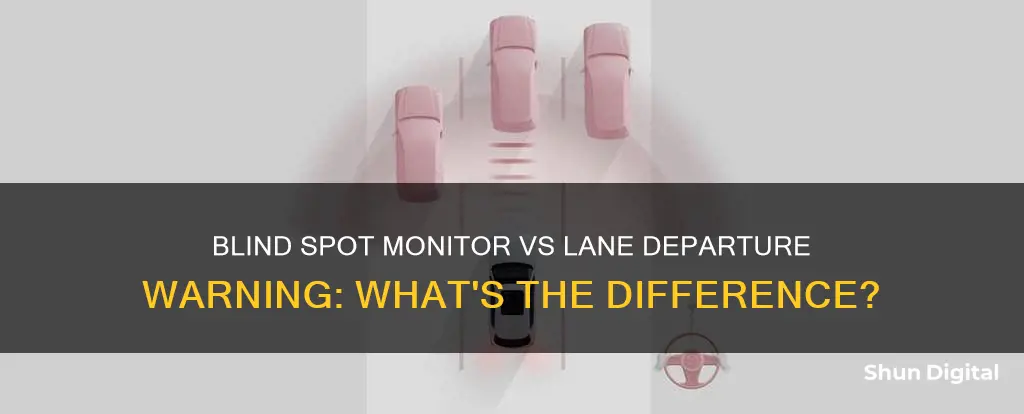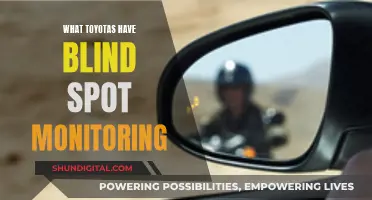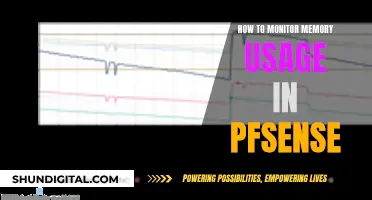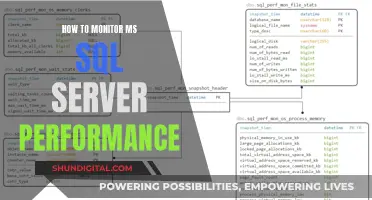
Blind spot monitors and lane departure warning systems are both modern safety features designed to keep drivers and passengers safe on the roads. While they are distinct features, they are often bundled together in vehicles. A blind spot detection system uses sensors to detect vehicles in the space behind and to the side of your car, alerting you to their presence. A lane departure warning system, on the other hand, uses a camera to monitor the vehicle's position within its lane and alerts the driver if they are drifting out of their lane. Lane-keeping assist takes this a step further by actively steering the vehicle back into the correct lane. While these systems are effective in preventing certain types of crashes, they are not perfect and should not be relied upon entirely. Drivers should remain engaged and aware of their surroundings at all times.
| Characteristics | Values |
|---|---|
| Purpose | Blind spot monitor: Offers reassurance that no vehicles are in a driver's blind spot. |
| Lane departure warning: Alerts a driver when they are changing lanes. | |
| Functionality | Blind spot monitor: Uses a suite of sensors to detect vehicles in the space behind and to the side of a car, and alerts the driver to their presence. |
| Lane departure warning: Uses a camera to monitor a vehicle's position in the lane and alerts the driver when the vehicle leaves its lane. | |
| Driver Action | Blind spot monitor: Does not absolve the driver from checking that the coast is clear before changing lanes. |
| Lane departure warning: Requires the driver to make the necessary steering and braking adjustments to get the car back into the correct lane. | |
| Limitations | Blind spot monitor: May not reliably detect fast-approaching vehicles or motorcycles. |
| Lane departure warning: May not work optimally if lane markings are unclear or weather conditions are poor. |
What You'll Learn
- Lane departure warning systems are designed to address often-fatal crashes
- Blind spot detection systems use sensors to detect vehicles in a driver's blind spot
- Lane-keeping assist systems use cameras and line-tracking technology to monitor a vehicle's position
- Blind spot monitors can reduce crashes caused by lane changes
- Lane departure warning systems are not a substitute for an engaged driver

Lane departure warning systems are designed to address often-fatal crashes
Lane departure warning systems work by scanning the road to locate lane markers and alerting the driver when the vehicle deviates from its lane. The system assumes the driver is crossing the lane intentionally if the turn signal is on and does not provide a warning. The driver must then respond accordingly and make the necessary steering and braking adjustments to return to their lane.
While lane departure warning systems are effective in preventing crashes, they are not perfect. For example, road conditions such as worn pavement markers, construction zones, and intersections can cause the system to lose track of the lane location. Additionally, drivers may find the litany of alerts and warnings confusing, especially if they are similar to those of other advanced driver assistance features.
To ensure the effective use of lane departure warning systems, drivers should familiarize themselves with the technology by consulting the vehicle's owner's manual. Staying engaged and not relying solely on the system is crucial, as it is not a substitute for an attentive driver.
Best 1060 GPUs for Running Three Monitors
You may want to see also

Blind spot detection systems use sensors to detect vehicles in a driver's blind spot
A 2015 study by the Insurance Institute for Highway Safety found that blind spot monitors can reduce crashes caused by lane changes by as much as 14%. However, it's important to note that blind spot monitors are not perfect and should not be solely relied upon when changing lanes.
Blind spot detection systems work by using sensors to scan the area behind and to the side of a vehicle. These sensors can be radar-based or camera-based. When the system detects a vehicle in the driver's blind spot, it will provide an alert to warn the driver. The alert can be in the form of a beep, a vibration, or a visual warning, such as a light in the side mirror or mounted inside the car.
Some vehicles also offer a rear cross-traffic alert, which uses the same sensors as the blind spot detection system to detect objects when the vehicle is backing up.
While blind spot detection systems can provide valuable assistance to drivers, they should not be relied upon solely. Drivers should still visually check their blind spots and use their turn signals when changing lanes. Additionally, these systems may have difficulty detecting fast-moving or approaching vehicles, as well as motorcycles.
Connecting Your iPad to a Large Monitor: A Simple Guide
You may want to see also

Lane-keeping assist systems use cameras and line-tracking technology to monitor a vehicle's position
Lane-keeping assist systems use cameras to monitor the vehicle's position within the driving lane. These cameras are typically mounted behind the rearview mirror or on the windshield and can capture a view of the road up to 150 feet away. The systems use this visual data to identify lane markers and detect whether the vehicle is drifting out of its lane. In some cases, lane-keeping assist systems can also follow" the vehicle in front.
When the lane-keeping assist system detects that the vehicle is drifting out of its lane, it can take corrective action to steer the vehicle back towards the centre of the lane. Some systems apply the brakes on one side of the car to nudge it back into the correct position, while newer systems use steering inputs to guide the vehicle. The steering input can range from gentle nudges to full-on interventions, depending on the system.
Lane-keeping assist systems are often bundled with other advanced driver-assistance features such as adaptive cruise control and autonomous emergency braking. These systems can enhance the safety and convenience of driving, but they are not a substitute for an attentive human driver. It is important for drivers to understand the limitations of their vehicle's lane-keeping assist system and to remain engaged and aware of their surroundings at all times.
Lane-keeping assist systems offer valuable benefits, especially for tired and distracted drivers. They can help prevent lane departure accidents, which can be dangerous and even fatal, especially on two-lane highways with oncoming traffic. These systems can also reduce the risk of rollover accidents by keeping the vehicle in its lane and on the road. Additionally, lane-keeping assist systems can provide gentle corrective action to keep the vehicle on course, improving safety and reducing driver workload.
Hooking Up a Third Monitor: Unlocking the Power of 1060
You may want to see also

Blind spot monitors can reduce crashes caused by lane changes
The Insurance Institute for Highway Safety conducted a study in 2015 that found that blind-spot monitors can reduce crashes caused by lane changes by as much as 14%. This lends statistical support to the idea that they do indeed work.
Blind spot monitors offer reassurance that no vehicle is in your blind spot, but they are not perfect, so it is important not to rely on them completely. Blind spot monitors are an aid, but they do not absolve you from checking that the coast is clear before changing lanes.
AAA conducted an extensive blind spot monitor test a few years ago and found that many couldn't reliably detect fast-approaching vehicles, and they had difficulty detecting motorcycles as quickly as other vehicles.
Lane departure warning systems, on the other hand, use a camera to monitor your vehicle's position in the lane and alert you when you are changing lanes. This is a passive system and does not actively intervene to prevent lane departure. It is up to the driver to make the necessary steering and braking adjustments to get the car back into the correct lane. Lane departure warning systems only provide a warning to the driver and do not take action to avoid a crash.
While blind spot monitors and lane departure warning systems are both safety features designed to prevent accidents, they function in different ways and have different limitations. Blind spot monitors use sensors to detect vehicles in your blind spot, while lane departure warning systems use a camera to monitor your vehicle's position in the lane.
Blind Spot Monitoring: Sensor Replacement and Installation Costs
You may want to see also

Lane departure warning systems are not a substitute for an engaged driver
Lane departure warning systems are electronic aids that notify the driver when their vehicle leaves its lane. They are designed to address often-fatal crashes, and new research shows that they are effective in doing so. Lane departure warning systems are not a substitute for an engaged driver, however. While they can help to prevent crashes, they are not perfect and can be affected by road conditions, such as worn pavement markers, construction zones, and intersections.
Lane departure warning systems use a camera to monitor the vehicle's position within its lane. When the vehicle approaches or crosses lane markers, the system alerts the driver through audio, visual, or haptic responses. These responses can include buzzes, lights, dashboard symbols, or vibrations in the steering wheel or seat. The system assumes that the driver is crossing the lane on purpose if the turn signal is on and will not provide a warning.
While lane departure warning systems can help prevent crashes, they are not a substitute for an engaged driver. Drivers should not rely solely on these systems and should continue to check their surroundings and use their turn signals. Lane departure warning systems have limitations and can be affected by various factors, such as road conditions and the speed of other vehicles.
Additionally, drivers should familiarize themselves with the specific lane departure warning system in their vehicle. Different systems have different features and capabilities, and understanding how the system works is crucial for effective use. For example, some systems use one camera, while others use two to create a 3D view of the surroundings. Some systems provide early warnings, while others provide late warnings. Drivers should also be aware of any necessary adjustments, such as re-calibration after installing a new windshield.
In conclusion, lane departure warning systems are valuable safety features that can help prevent crashes and make driving safer and less stressful. However, they should not be seen as a replacement for an engaged and skilled driver. Drivers should stay alert, be aware of the limitations of their vehicle's system, and continue to follow safe driving practices.
Finding the Perfect Color Profile for Your Monitor
You may want to see also
Frequently asked questions
A blind spot monitor uses a suite of sensors to detect vehicles in the space behind and to the side of your car, and alerts you to their presence.
A lane departure warning system uses a camera to monitor the vehicle's position in the lane and alerts the driver when the vehicle leaves its lane.
No, they are different systems with different functions. Blind spot monitors detect vehicles in your blind spot, while lane departure warning systems detect when your vehicle is leaving its lane.







